New Mexico is home to a diverse range of scorpions, from small, harmless species to the highly venomous Arizona Bark Scorpion. These nocturnal predators thrive in the state’s desert and semi-arid regions, blending seamlessly into rocks, soil, and vegetation. Understanding their characteristics can help residents stay safe while appreciating the unique wildlife.
While most scorpions in New Mexico have mild venom, a few species pose a real risk to humans and pets. Recognizing the differences in size, color, and habitat is essential for identification and prevention of stings. Observing them at night or in natural shelters provides insight into their behavior and ecological role.
This guide covers 12 of the most common scorpions in New Mexico, offering detailed descriptions, identification tips, and information about venom potency and habitats. It is designed to help both enthusiasts and residents recognize and safely coexist with these fascinating arachnids.
Types of Scorpions Found in New Mexico
Arizona Bark Scorpion (Centruroides sculpturatus)
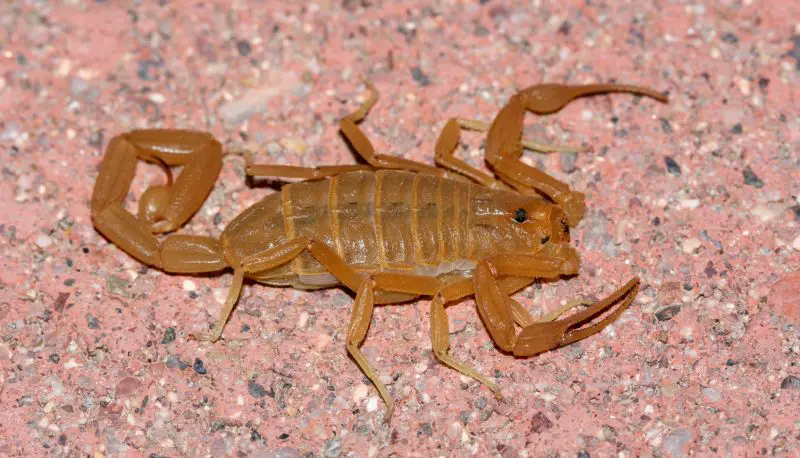
The Arizona Bark Scorpion is the most infamous scorpion species in New Mexico and North America. Its slender body measures approximately 2.5 inches (6–7 cm) and is a pale yellow or tan color, allowing it to blend seamlessly into the desert landscape. Its long, delicate pincers and narrow tail, tipped with a venomous stinger, make it instantly recognizable. The scorpion’s agility enables it to climb walls, tree trunks, and even ceilings, which increases the chance of human encounters.
This species is highly venomous, and its sting can cause intense pain, numbness, muscle twitching, vomiting, and in rare cases, difficulty breathing. Children, elderly individuals, and those with weakened immune systems are particularly vulnerable to its venom. Despite the severity of its sting, fatalities are extremely rare due to available medical care and antivenom treatments.
Arizona Bark Scorpions are nocturnal hunters, emerging at night to feed on insects, spiders, and other small prey. During the daytime, they hide under rocks, in crevices, beneath logs, or inside human dwellings. Their climbing ability allows them to explore vertical surfaces in search of food or shelter, making them particularly adaptable to different environments.
These scorpions are primarily found in the southwestern regions of New Mexico, especially in desert and semi-arid habitats. They thrive in warm, dry climates and are often spotted around human homes, which can lead to accidental encounters. They are considered one of the most dangerous arthropods in the state due to their potent venom and proximity to people.
Striped Bark Scorpion (Centruroides vittatus)
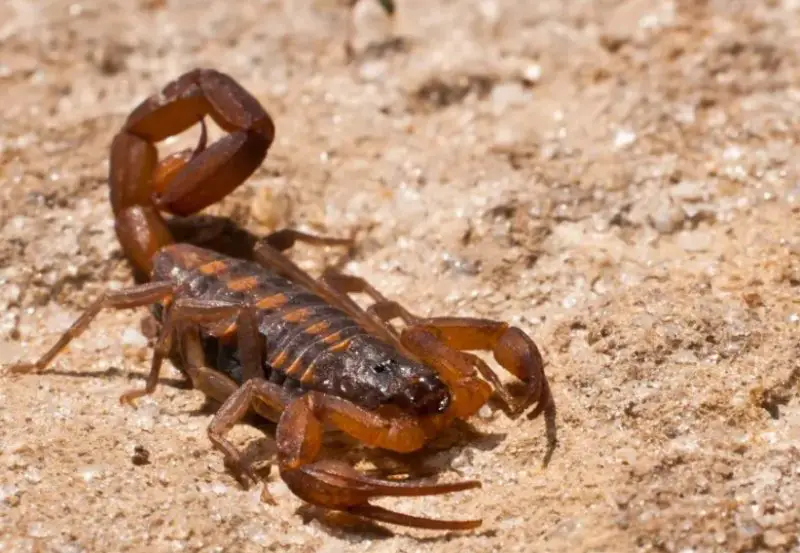
The Striped Bark Scorpion is a medium-sized species, usually measuring around 2 inches (5–6 cm) in length. Its body coloration ranges from pale yellow to light brown, with dark longitudinal stripes along its back, giving it a distinctive appearance. The slender tail and pincers differentiate it from larger desert species, while its delicate body allows it to move quickly across rocky and sandy terrain.
Although venomous, this species is much less dangerous than the Arizona Bark Scorpion. Its sting typically causes localized pain, redness, and mild swelling but is rarely life-threatening. Most reactions subside within a few hours, though sensitive individuals may experience slightly stronger symptoms.
Striped Bark Scorpions are nocturnal predators that feed primarily on insects and small spiders. They spend daylight hours concealed under rocks, tree bark, or debris. Their climbing ability allows them to explore walls, fences, and even the exterior of homes, which occasionally brings them into contact with humans.
In New Mexico, Striped Bark Scorpions are widespread, particularly in central and eastern regions. They prefer dry habitats such as grasslands, shrublands, and semi-desert areas but can tolerate slightly more humid microenvironments. Their adaptability and moderate abundance make them one of the most commonly encountered scorpions in the state.
Giant Desert Hairy Scorpion (Hadrurus arizonensis)
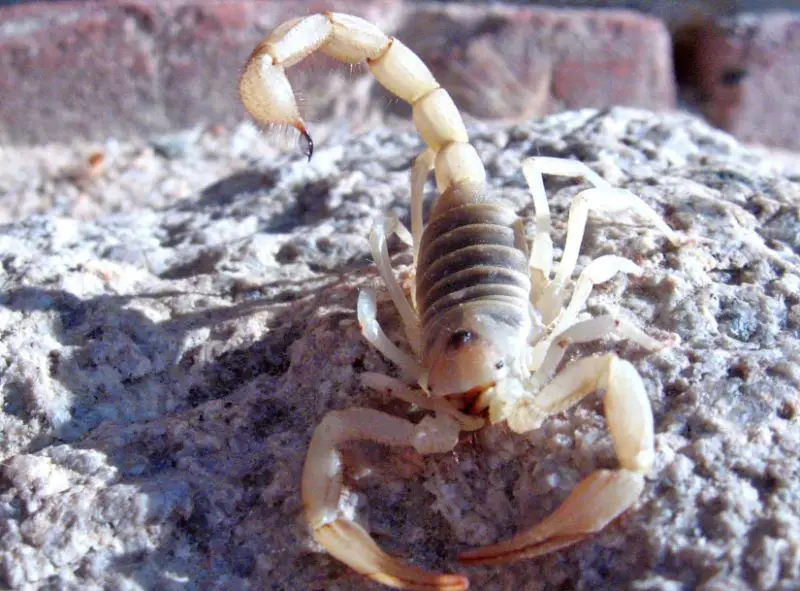
The Giant Desert Hairy Scorpion is the largest scorpion in North America, growing up to 5–6 inches (12–14 cm) in length. Its robust body is covered in fine hairs, giving it a slightly fuzzy appearance, and it typically has a dark brown or tan coloration. Its thick pincers are strong enough to capture and hold prey, while its substantial tail delivers a defensive sting when threatened.
Despite its intimidating size, the venom of the Giant Desert Hairy Scorpion is relatively mild. A sting generally causes pain similar to a bee sting, accompanied by redness and minor swelling. The primary danger of this scorpion is its size, which can startle humans or pets, rather than its venom.
These scorpions are nocturnal hunters, preying on insects, spiders, and other invertebrates. During the day, they remain hidden in burrows they dig in sandy soil or under rocks. Their large size provides some defense against predators, but they are still preyed upon by birds, mammals, and lizards.
In New Mexico, Giant Desert Hairy Scorpions are commonly found in desert regions, particularly in the western and southern parts of the state. They favor loose, sandy soil for burrowing and are rarely encountered in urban areas, preferring more natural, undisturbed habitats.
Striped Devil Scorpion (Paravaejovis spinigerus)
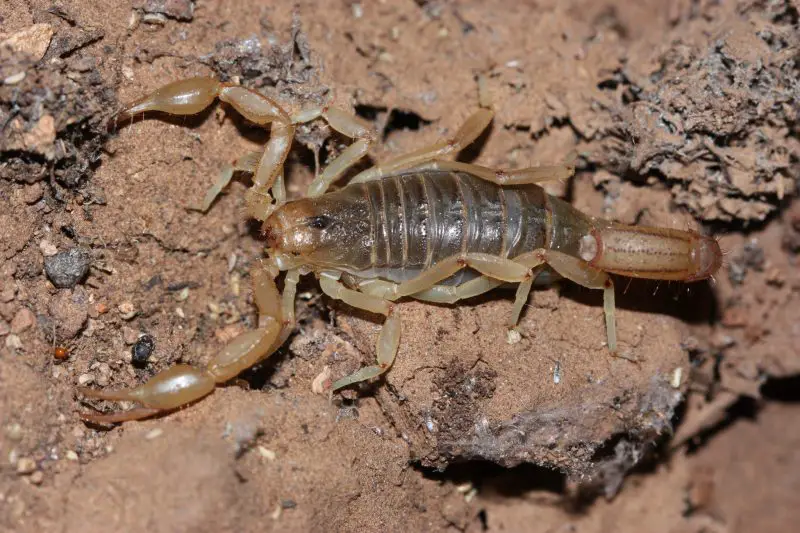
The Striped Devil Scorpion is a moderately sized species with a yellowish-brown body and darker stripes running along the dorsal surface. Its thick tail and strong pincers give it a sturdy appearance, although it is smaller than the Giant Desert Hairy Scorpion. Its coloration and markings help it camouflage among rocks and desert vegetation.
This species has mild venom that generally causes localized pain, swelling, and redness. It is considered harmless to humans unless an allergic reaction occurs. Despite its limited threat, the scorpion displays defensive behaviors by raising its pincers and tail to appear larger when confronted.
Nocturnal by nature, the Striped Devil Scorpion hunts insects and other small arthropods under the cover of darkness. During the daytime, it shelters beneath rocks, leaf litter, or wood to avoid heat and predators. Its behavior is secretive, and it usually avoids direct contact with humans.
In New Mexico, the Striped Devil Scorpion is most commonly found in western desert regions. It favors rocky and scrubland habitats, where it can find ample shelter and prey. Its adaptability to various microhabitats allows it to persist across a wide range of terrain in the state.
Cash’s Scorpion (Vaejovis cashi)
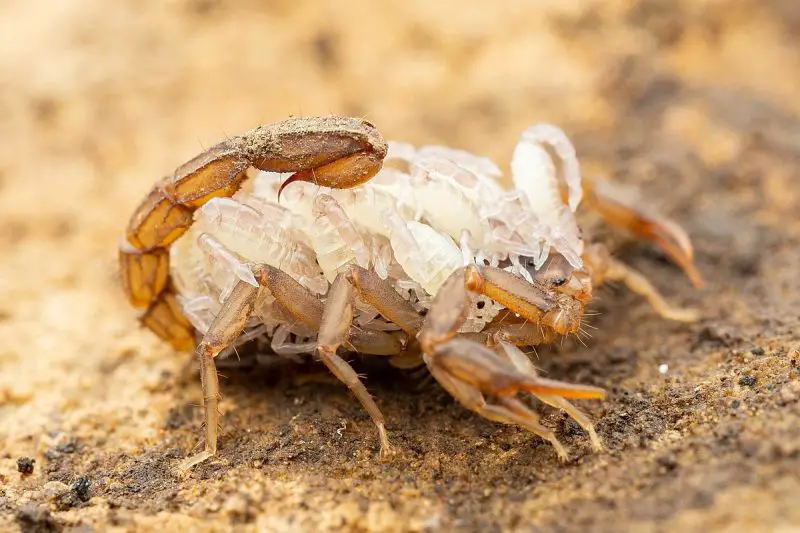
Cash’s Scorpion is a smaller species with a reddish-purple body and a slender tail. Unlike some desert scorpions, it does not excavate deep burrows, instead taking refuge under rocks, logs, or other natural debris during the day. Its muted coloration allows it to blend seamlessly into arid landscapes.
The venom of Cash’s Scorpion is weak and rarely harmful to humans. A sting typically produces minor pain and slight swelling at the site. It is considered one of the least dangerous scorpions in New Mexico, though individuals should still exercise caution when handling or encountering it.
This scorpion is nocturnal, emerging at night to feed on insects and other small invertebrates. Its behavior is reclusive, and it generally avoids humans, retreating quickly when disturbed. It uses its tail defensively but relies on camouflage and speed to escape threats.
Cash’s Scorpion primarily inhabits the southwestern regions of New Mexico, favoring rocky, arid terrain. It is rarely seen in urban or suburban areas, preferring undisturbed natural habitats where it can find both shelter and prey. Its small size and discreet behavior make it less noticeable compared to other scorpion species in the state.
Lesser Stripetail Scorpion (Chihuahuanus coahuilae)
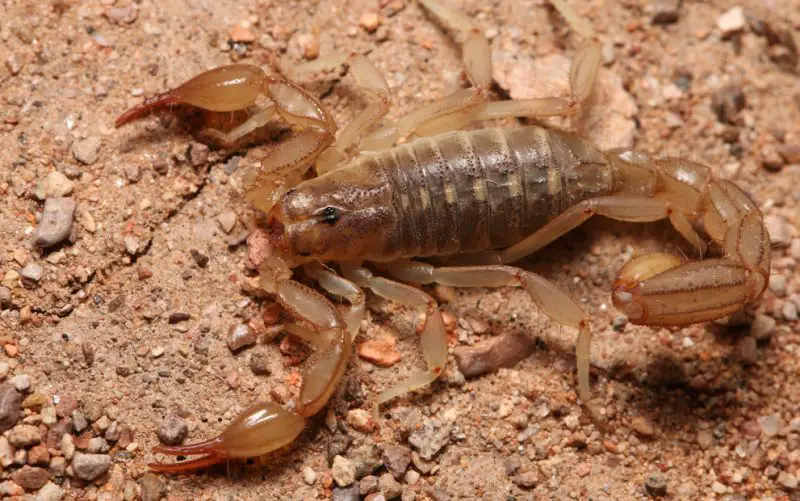
The Lesser Stripetail Scorpion is a relatively small species, with a body length of 3.5–5.5 cm. Its slender tail is striped, and its overall coloration ranges from light brown to yellowish, which provides excellent camouflage among rocks and desert soil. Its delicate pincers are suited for grasping small prey, and its agility allows it to navigate rocky crevices with ease.
Its venom is mild and typically causes minor pain and swelling if it stings a human. Most reactions are brief, making this species a low-risk scorpion for people. Allergic individuals should still exercise caution, though serious medical issues are extremely rare.
Nocturnal by habit, the Lesser Stripetail Scorpion hunts insects, spiders, and other small arthropods. During the day, it hides under rocks, fallen logs, or in shallow burrows, avoiding predators and extreme heat. Its reclusive behavior makes it less likely to be noticed by humans.
In New Mexico, this scorpion is widespread across desert and grassland areas, particularly in the southern and central parts of the state. It thrives in dry, rocky, and semi-arid habitats where shelter is readily available.
Vaejovis carolinianus

Vaejovis carolinianus is a small, brown scorpion that is often found hiding in crevices, under rocks, or beneath leaf litter. Its body is relatively smooth, and it has moderately sized pincers and a slender tail. Its coloring allows it to blend into its surroundings, making it difficult to spot during the day.
This species has a weak venom that is generally harmless to humans. A sting may produce temporary pain or slight swelling but is not considered dangerous. Its main defense is its secretive nature rather than aggression.
Nocturnal activity drives its feeding behavior, with a diet consisting of insects and other invertebrates. It avoids open areas during the day and prefers the protection of natural cover to minimize exposure to predators.
In New Mexico, Vaejovis carolinianus is found primarily in the eastern parts of the state. It favors dry habitats with abundant shelter options, including rocky hillsides, scrublands, and semi-forested areas.
Vaejovis punctatus
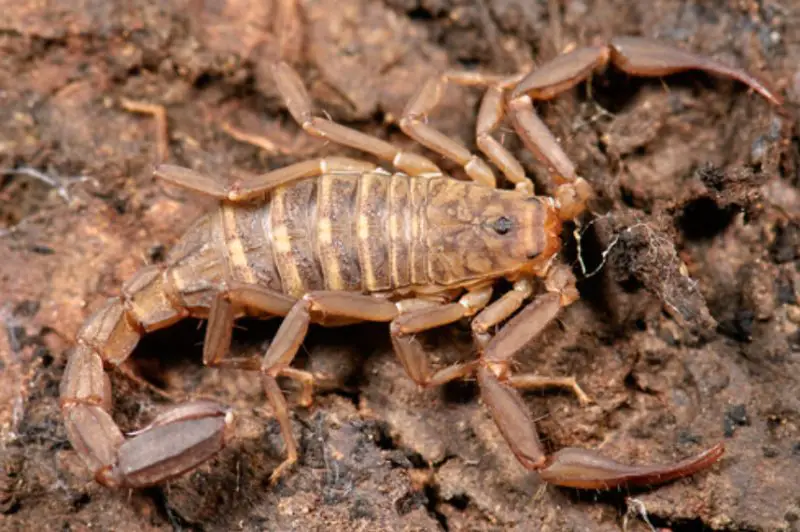
Vaejovis punctatus is a small to medium-sized scorpion, typically brown with dark spots or punctate markings along its back. Its robust tail and pincers allow it to capture prey effectively, though it is not aggressive toward humans. Its body shape and markings provide camouflage against desert rocks and soil.
The venom is mild and generally only causes localized pain, redness, or swelling. Serious reactions are extremely rare, making it a low-risk species. Its primary defense is hiding rather than stinging.
This scorpion is nocturnal and hunts insects and other small arthropods at night. During the day, it hides under rocks or within cracks in the ground to avoid predators and harsh sunlight. Its behavior is cautious and reclusive.
Vaejovis punctatus is most commonly found in western New Mexico, particularly in arid and semi-arid rocky terrain. It is well-adapted to desert life, seeking shelter wherever natural cover is available.
Paruroctonus boreus
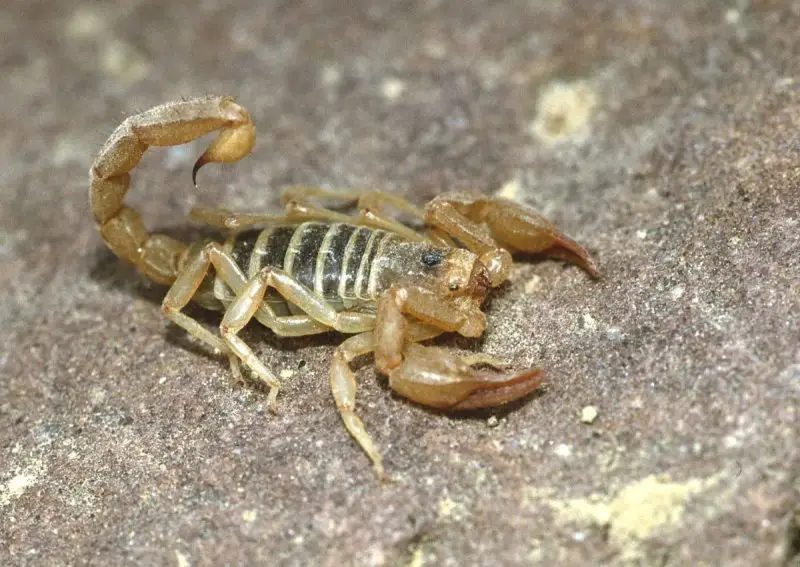
Paruroctonus boreus is a small, pale scorpion with a relatively long tail. Its body color ranges from tan to light brown, blending well with sandy and rocky environments. Its slender pincers and agile movements allow it to capture small prey efficiently.
The venom of this species is weak and rarely harmful to humans, usually causing minor pain and temporary swelling at the sting site. It relies on speed and camouflage for protection rather than venom potency.
Nocturnal by nature, Paruroctonus boreus emerges at night to hunt insects and spiders. It takes refuge under rocks, soil clumps, or debris during the day to avoid heat and predators. Its shy demeanor reduces the likelihood of human encounters.
In New Mexico, this species is primarily found in desert and semi-desert regions, especially in the southern and central areas. It prefers dry, sandy soil where it can dig shallow burrows or take shelter under natural cover.
Paruroctonus silvestrii
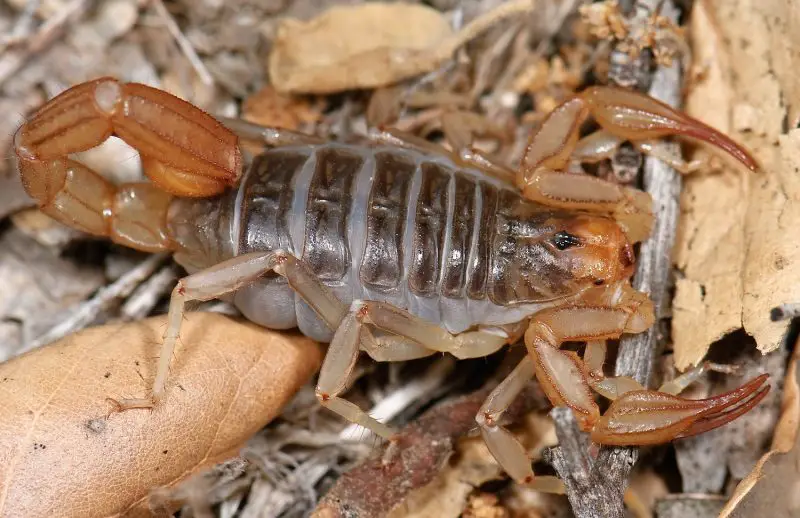
Paruroctonus silvestrii is a medium-sized, light brown scorpion with a long, thin tail and moderate pincers. Its coloration allows it to blend seamlessly into desert and scrubland habitats, making it difficult to detect. It is agile and capable of moving quickly across sandy or rocky terrain.
Its venom is mild and generally harmless to humans, producing only temporary discomfort if stung. The scorpion’s main defense is to retreat quickly rather than confront threats.
This species is nocturnal and preys on insects and other small arthropods. During daylight hours, it seeks shelter under rocks, logs, or soil depressions to avoid predators and extreme temperatures. Its cautious nature helps it avoid danger effectively.
Paruroctonus silvestrii is distributed in central New Mexico, primarily inhabiting desert plains, scrublands, and rocky areas. It favors habitats where it can find ample hiding spots and food sources.
Hadrurus spadix
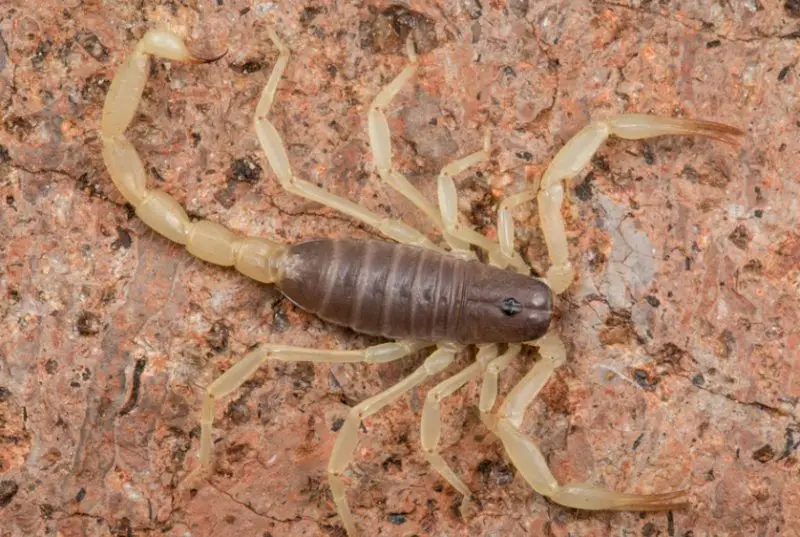
Hadrurus spadix is a large scorpion with a dark brown body covered in fine hairs. It has strong, robust pincers and a thick tail tipped with a stinger, giving it a formidable appearance. Its body length ranges from 10 to 12 cm, making it one of the more noticeable scorpions in New Mexico.
The venom is relatively mild compared to its size, causing localized pain and redness similar to a bee sting. It poses little risk to humans beyond the initial discomfort of a sting. Its large size provides intimidation against predators, although it can still fall prey to birds, mammals, and reptiles.
This scorpion is nocturnal, hunting insects, spiders, and small invertebrates at night. During the day, it hides in burrows, under rocks, or in other natural shelters. Its robust body allows it to dig shallow burrows if soil conditions permit.
Hadrurus spadix is primarily found in western New Mexico, inhabiting desert and semi-desert areas with loose, sandy soil. It avoids urban environments and is most commonly encountered in undisturbed natural habitats.
Vaejovis lapidicola

Vaejovis lapidicola is a small, brown scorpion that inhabits rocky areas. Its slender tail and moderately sized pincers allow it to capture prey effectively while navigating narrow crevices. Its dark coloration provides excellent camouflage among stones and desert terrain.
Its venom is weak and typically only produces minor pain and slight swelling if it stings a human. Serious medical issues from this species are extremely rare. It relies primarily on hiding and retreating to avoid danger.
This scorpion is nocturnal, emerging at night to feed on insects and other small arthropods. During the day, it remains concealed under rocks, logs, or within small natural crevices, minimizing exposure to predators and heat.
Vaejovis lapidicola is most commonly found in southwestern New Mexico, where rocky terrain and arid conditions provide ideal shelter and hunting grounds. Its small size and discreet behavior make it less noticeable than larger scorpion species in the state.
FAQs About Scorpions in New Mexico
What types of scorpions are found in New Mexico?
New Mexico is home to around 25 scorpion species, but the most common include the Arizona Bark Scorpion (Centruroides sculpturatus), Striped Bark Scorpion (Centruroides vittatus), Giant Desert Hairy Scorpion (Hadrurus arizonensis), Striped Devil Scorpion (Paravaejovis spinigerus), and Cash’s Scorpion (Vaejovis cashi). Other notable species include Lesser Stripetail Scorpion (Chihuahuanus coahuilae) and Vaejovis lapidicola.
Are scorpions in New Mexico dangerous to humans?
Most scorpions in New Mexico have mild venom that only causes localized pain, redness, and swelling. The Arizona Bark Scorpion is the exception, as its sting can cause severe pain, numbness, and in rare cases, serious health issues, particularly for children, the elderly, or those with weakened immune systems.
When and where are scorpions most active in New Mexico?
Scorpions are primarily nocturnal. They are most active at night when they hunt for insects and other small prey. During the day, they hide under rocks, logs, leaf litter, or inside crevices. Desert and semi-arid regions provide ideal habitats, but some species can be found near human dwellings, especially in southwestern New Mexico.
How can I prevent scorpion stings at home?
To reduce the risk of scorpion stings, keep your home and yard clear of debris, woodpiles, and rocks. Seal cracks and crevices in walls, doors, and windows. Shake out shoes, clothing, and bedding before use, especially in areas known to have Arizona Bark Scorpions. Installing weather stripping and door sweeps can also help prevent scorpions from entering.
What should I do if stung by a scorpion in New Mexico?
For mild stings, clean the affected area with soap and water, apply a cool compress, and take over-the-counter pain relievers if needed. Monitor for unusual symptoms such as difficulty breathing, severe swelling, or persistent pain. Seek medical attention immediately if stung by an Arizona Bark Scorpion or if any severe symptoms occur.
Do scorpions in New Mexico bite pets?
Yes, pets such as dogs and cats can be stung by scorpions. While most stings cause minor pain and discomfort, the Arizona Bark Scorpion can pose a serious risk. Signs of a scorpion sting in pets include drooling, muscle twitching, vomiting, and unusual behavior. Veterinary attention should be sought immediately if a severe sting is suspected.
Can scorpions survive in urban areas of New Mexico?
While most scorpions prefer desert or semi-arid habitats, some species, like the Arizona Bark Scorpion and Striped Bark Scorpion, can adapt to urban environments. They may take shelter in cracks, under rocks, in garages, or near foundations, especially in areas with abundant prey.






